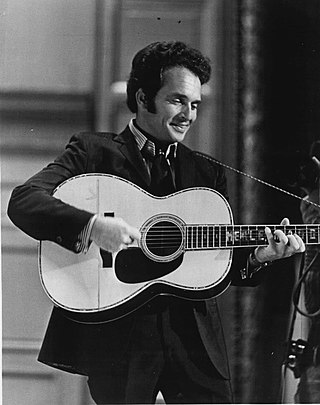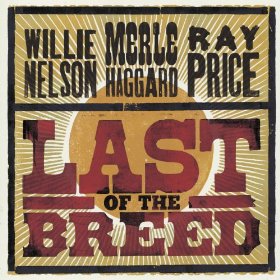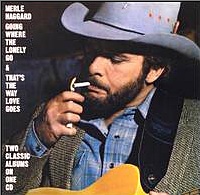Related Research Articles

Merle Ronald Haggard was an American country music singer, songwriter, guitarist, and fiddler.

Pancho & Lefty by Townes Van Zandt (1972) became well-known through a honky tonk album by outlaw country musicians Merle Haggard and Willie Nelson, released in 1983. Original vinyl copies from 1983 give the album's title as "Poncho & Lefty" on the cover, as well as on the inner sleeve and the record label; the album's title track is similarly rendered "Poncho & Lefty" on the cover, inner sleeve, and label. Later editions correct the title to the intended "Pancho & Lefty.” They are backed by Don Markham of The Strangers.

John Townes Van Zandt was an American singer-songwriter. He wrote numerous songs, such as "Pancho and Lefty", "For the Sake of the Song", "If I Needed You", "Snake Mountain Blues", "Our Mother the Mountain", "Waitin' Round to Die", and "To Live Is to Fly". His musical style has often been described as melancholic and features rich, poetic lyrics. During his early years, Van Zandt was respected for his guitar playing and fingerpicking ability.

Luxury Liner is the fourth studio album by American country music artist Emmylou Harris, released in 1976. The album was Harris' second successive number one country album on the Billboard charts, although, unlike the preceding Elite Hotel, there were no number one hits from this album. The highest-charting singles were the number six Chuck Berry cover "(You Never Can Tell) C'est la Vie" and the number eight "Making Believe". However, the album may be better known for including the first cover version of Townes Van Zandt's 1972 song "Pancho and Lefty", which subsequently became Van Zandt's best-known composition.

Live at the Old Quarter, Houston, Texas is a double live album by Texas singer-songwriter Townes Van Zandt. The recording captures Van Zandt in a series of July 1973 performances in an intimate venue Old Quarter. There is a strong critical consensus that this recording is among the most exemplary of Van Zandt's career.

The Late Great Townes Van Zandt is a 1972 studio album by American singer-songwriter Townes Van Zandt. It was the second album that he recorded in 1972, and a follow-up to High, Low and In Between.

Last of the Breed is a two-disc album by American country music artists Willie Nelson, Merle Haggard and Ray Price, released in 2007. It debuted at number 64 on the U.S. Billboard 200, selling about 13,000 copies in its first week. The album has 100,000 copies in the U.S. as of May 2015. The album was ranked number 33 on Rolling Stone's list of the Top 50 Albums of 2007.

At My Window is an album released by folk/country singer-songwriter Townes Van Zandt in 1987. This was Van Zandt's first studio album in the nine years that followed 1978's Flyin' Shoes, and his only studio album recorded in the 1980s.

"Mama Tried" is a song written and recorded by American country music artist Merle Haggard and The Strangers. It was released in July 1968 as the first single and title track from the album Mama Tried. The song became one of the cornerstone songs of his career. It won the Grammy Hall of Fame Award in 1999, and was selected for preservation in the National Recording Registry due to its "cultural, historic, or artistic significance" on March 23, 2016, just 14 days before Haggard's death. In 2021, it was ranked at #376 on Rolling Stone's "500 Greatest Songs of All Time".

Going Where the Lonely Go is the thirty-fifth studio album by American recording artist Merle Haggard backed by The Strangers, released in 1982.

Hag is the twelfth studio album by American country music artist Merle Haggard and The Strangers released on Capitol Records in 1971. It became his fifth album to top the Billboard country album charts. It also reached number 66 on the pop albums chart.

Always on My Mind is the 27th studio album by country singer Willie Nelson. It was the Billboard number one country album of the year for 1982, and stayed 253 weeks on the Billboard Top Country Albums charts, peaking at number one for a total of 22 weeks, as well as spending 99 weeks on the all-genre Billboard 200, peaking at number two for 3 weeks.

Songs is a 2005 compilation album by country singer Willie Nelson.
"I Always Get Lucky With You" is a song written by Merle Haggard, Freddy Powers, Gary Church, and Tex Whitson. It was first recorded by Haggard on his 1981 album Big City and then covered by American country music artist George Jones in April 1983 as the second single from the album Shine On. The song was Jones' ninth and final number one on the country chart as a solo artist. The single stayed at number one for one week and spent thirteen weeks on the country chart.
"Reasons to Quit" is a song recorded by American country music artists Merle Haggard and Willie Nelson. It was released in January 1983 as the first single from the album Pancho & Lefty. The song reached #6 on the Billboard Hot Country Singles & Tracks chart. The song was written by Haggard.
The Pedernales Country Club is a complex located in Lake Travis, 29 miles west of Austin, Texas, United States. Originally the Briarcliff Yacht and Golf Club, a nine-hole golf course constructed in 1968, it was purchased by country music singer-songwriter Willie Nelson in 1979. After the purchase, Nelson constructed a studio on the complex, designed by Chips Moman. The first recording on the studio was Nelson's release Tougher Than Leather and his collaboration with Merle Haggard Pancho and Lefty.

Walking the Line is an album by American country music artists Merle Haggard, George Jones, and Willie Nelson, released in 1987.

Heart to Heart is a duet album by Merle Haggard and Leona Williams with backing by the Strangers, released in June 1983 on Mercury Records. It reached number 44 on the Billboard Country music chart.

Seashores of Old Mexico is a studio album by Merle Haggard and Willie Nelson. It is a sequel to their enormously successful 1983 duet album Pancho and Lefty and was released in 1987. They are backed by The Strangers. The only charting single was a cover of a 1979 Blaze Foley song, "If I Could Only Fly", which peaked at number 58 on the 1987 Billboard Hot Country Songs singles chart.

Django and Jimmie is the sixth and final collaborative studio album by American country music artists Willie Nelson and Merle Haggard. It was released on June 2, 2015, by Legacy Recordings. The album was Haggard's final studio album prior to his death of pneumonia in April 2016, 10 months after its release.
References
- ↑ "Poncho and Lefty" (Media notes). Townes Van Zandt. United Artists Records, Inc. 1972.
{{cite AV media notes}}: CS1 maint: others in cite AV media (notes) (link) - ↑ The Late Great Townes Van Zandt (Media notes). Townes Van Zandt. United Artists Records, Inc. 1972.
{{cite AV media notes}}: CS1 maint: others in cite AV media (notes) (link) - ↑ Donald Clarke. The Penguin Encyclopedia of Popular Music. Penguin Books, 1990. pp. 518. ISBN 9780140511475
- ↑ Richard Carlin. The Big Book of Country Music: A Biographical Encyclopedia. Penguin, 1995. p. 472. ISBN 9780140235098
- ↑ Luxury Liner (Media notes). Emmylou Harris. Warner Bros. Records Inc. 1977.
{{cite AV media notes}}: CS1 maint: others in cite AV media (notes) (link) - ↑ Nathan Brackett and Christian David Hoard. The New Rolling Stone Album Guide. Simon and Schuster, 2004. p. 366. ISBN 9780743201698
- ↑ "'Poncho And Lefty' Push." Billboard.95.5. 12 February 1983. p. 42. ISSN 0006-2510
- ↑ "Hot Country LPs." Billboard.95.13. 26 March 1983. p. 48. ISSN 0006-2510
- ↑ Poncho & Lefty (Media notes). Merle Haggard / Willie Nelson. 1982.
{{cite AV media notes}}: CS1 maint: others in cite AV media (notes) (link) - ↑ Poncho & Lefty (Media notes). Merle Haggard / Willie Nelson. 1982.
{{cite AV media notes}}: CS1 maint: others in cite AV media (notes) (link) - ↑ "Pancho And Lefty" (Media notes). Willie Nelson and Merle Haggard. CBS Inc. 1982.
{{cite AV media notes}}: CS1 maint: others in cite AV media (notes) (link) - ↑ The Late Great Townes Van Zandt (Media notes). Townes Van Zandt. The Tomato Music Works Limited. 2003.
{{cite AV media notes}}: CS1 maint: others in cite AV media (notes) (link) - ↑ Luxury Liner (Media notes). Emmylou Harris. Warner Bros. Records Inc. 2004.
{{cite AV media notes}}: CS1 maint: others in cite AV media (notes) (link) - ↑ Beviglia, Jim (April 30, 2012). "Townes Van Zandt, "Pancho and Lefty"". American Songwriter. Retrieved June 5, 2012.
- ↑ 1984 PBS series, "Austin Pickers". Ed Heffelfinger. (0:00:32)
- ↑ Margaret Brown (director). Be Here To Love Me: A Film About Townes Van Zandt (motion picture). 2004. (1:10:30)
- ↑ Graeme Thomson (2006). Willie Nelson: The Outlaw. Random House. ISBN 9781448133413.
- 1 2 Margaret Brown (director). Be Here To Love Me: A Film About Townes Van Zandt (motion picture). 2004. (1:09:25)
- 1 2 Blase S. Scarnati. "Chapter 7: Shifting Time and Cinematic Images: Townes Van Zandt, Willie Nelson. Merle Haggard, and "Pancho and Lefty"." For the Sake of the Song: Essays on Townes Van Zandt. Ann Norton Holbrook and Dan Beller-McKenna. eds. University of North Texas Press, 2022. pp. 131. ISBN 9781574418705
- ↑ Blase S. Scarnati. "Chapter 7: Shifting Time and Cinematic Images: Townes Van Zandt, Willie Nelson. Merle Haggard, and "Pancho and Lefty"." For the Sake of the Song: Essays on Townes Van Zandt. Ann Norton Holbrook and Dan Beller-McKenna. eds. University of North Texas Press, 2022. pp. 136. ISBN 9781574418705
- 1 2 3 4 5 Aretha Sills. "Muddy Waters and Mozart: Remembering Townes Van Zandt." Los Angeles Review of Books. 1 January 2012. Retrieved 10 August 2022.
- ↑ John Kruth. "Townes Van Zandt: The Self-Destructive Hobo Saint." Sing Out.48.2 (Summer 2004). (pna)
- ↑ Margaret Brown (director). Be Here To Love Me: A Film About Townes Van Zandt (motion picture). 2004. (0:07:14)
- ↑ Bjorke, Matt (October 8, 2019). "Top 30 Country Digital Singles Chart: October 7, 2019". RoughStock. Retrieved October 11, 2019.
- ↑ Sheffield, Rob (February 24, 2023). "The 100 Best Songs of 1983, the Year Pop Went Crazy". Rolling Stone . Retrieved September 4, 2023.
Two great country outlaws team up for a classic outlaw ballad: "Pancho and Lefty," by Texas songwriter Townes Van Zandt.
- ↑ Whitburn, Joel (2004). The Billboard Book Of Top 40 Country Hits: 1944-2006, Second edition. Record Research. p. 148.
- ↑ "The Grammy Hall of Fame". Grammy Awards. Retrieved 7 Feb 2022.
- ↑ Western Writers of America (2010). "The Top 100 Western Songs". American Cowboy. Archived from the original on October 19, 2010.
- ↑ "100 Greatest Country Songs of All Time - Rolling Stone". Rolling Stone . June 2014.
- ↑ "The 500 Greatest Songs of All Time". Rolling Stone. 2021-09-15. Retrieved 2021-09-16.
- ↑ "Willie Nelson Chart History (Adult Contemporary)". Billboard. Retrieved June 20, 2021.
- ↑ "Willie Nelson Chart History (Hot Country Songs)". Billboard. Retrieved June 20, 2021.
- ↑ "1984 Talent Almanac" (PDF). Billboard. Vol. 95, no. 51. December 24, 1983. p. TA-24. Retrieved June 20, 2021.